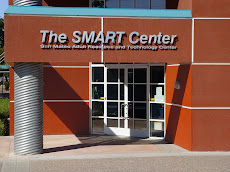Leticia Navarro
A visitor to Leticia Navarro’s fourth/fifth grade class in the Fiesta Gardens Spanish/English bilingual immersion school in San Mateo, is struck by how quickly the children volunteer answers. A flow of Spanish with an occasional English word woven in if the Spanish doesn’t come quickly to mind, serves to get the point across. All the students are using the language they have to engage in the task at hand, whether the lesson of the moment is in Spanish or English.
“That’s one of the things I learned from my experience as a student in ESL classes at the Adult School”, Leticia notes. “Make a comfortable atmosphere where the students can be free to use the language they have to communicate. When I first came to the United States I was so afraid to say anything or go anywhere. Then I came to the San Mateo Adult School and my life in the United States changed.”
Leticia came to the United States from Mexico in 1989 after she had finished high school. Her father had come to the United States many years before and had been part of the Amnesty program of 1986. In 1989 with his immigration status stabilized, he was able to reunite with his family. Leticia’s father had benefited from the Adult School by taking the English classes he needed in order to qualify for Amnesty.
Encouraged by her family, one of Leticia’s first stops was the San Mateo Adult School where she enrolled in English as a Second Language (ESL) classes. From the beginning Leticia was struck by the manner that the classes were taught. Students were constantly encouraged to use the English that they had acquired. “The thing I remember most about my first class with Tim Doyle is that we went on field trips into the community. We learned how to take public transportation by riding on the bus and the train. I had never gone anywhere in the United States by myself without my father or brother. After we took a school trip to San Francisco, some friends that I had met in the class and I went by ourselves on the weekend to San Francisco. I felt so independent.”
She was so inspired by another teacher, Maria Roddy, who gave short critical thinking passages from famous writers in her Low Advanced ESL class that Leticia struggled mightily and read her first book in English, Les Miserables. Leticia studied morning through evenings and eventually honed her skills in ABE classes to the point where she felt ready to go on to community college. There Leticia balanced school, a job and romance, getting married to a man who like herself chose to go on to a four year college to become a teacher.
Leticia is now a pillar at the Fiesta Gardens school where parents, administrators and kids refer to her as “the wonderful Ms. Navarro” In her nine years at the school she has spent much time with the native Spanish and English speaking children with their struggles to acquire a second language. Her recent challenge along with all public education teachers is how to respond to the increased pressures of standardized testing, made worse by the fact that her students have to take standardized tests in two languages. An added pressure from the testing is that students in bilingual programs often do not manifest high test scores until their sixth or seventh year in bilingual schools. Panicked parents need constant reassurance that their children are learning at an appropriate pace and will eventually come out with higher cognitive abilities than their single language peers.
For Leticia the classroom is a place of transformation, where students can learn and grow. For her, part of the path was formed at Adult School where she says she gained a foundation in a new language and new culture and at the same time learned about how education could happen in a new way.
Wednesday, June 24, 2015
Subscribe to:
Post Comments (Atom)


No comments:
Post a Comment